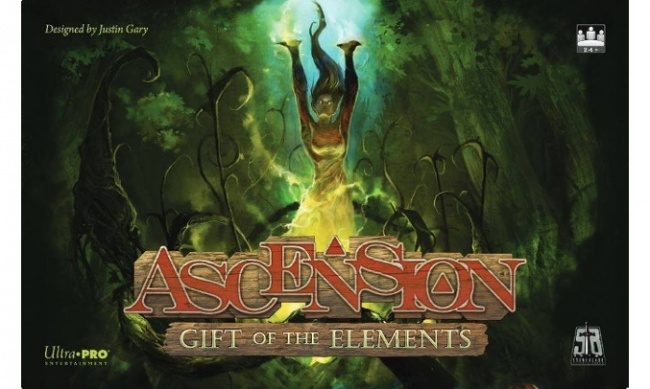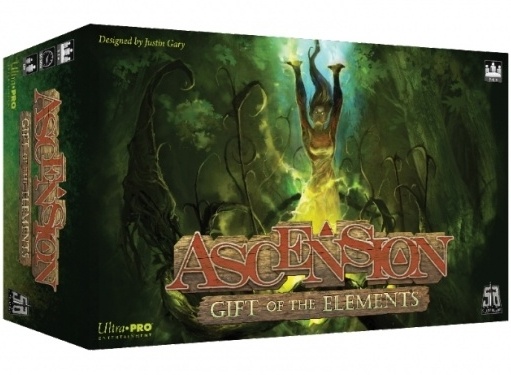Ascension: Gift of the Elements
Publisher: Stone Blade Entertainment
Release Date (US): April, 2017
Price: $39.99
Game Designer: Justin Gary
Format: Deck-Building Game
Number of Players: 1 to 4
Playing Time: 30-60 minutes
Age Rating: 13 and up
Product #: 3999UP10080
ICv2 Rating: 4 Stars out of 5
Some years ago, I was introduced to Ascension: Chronicle of the Godslayer, at that time one of the few games in the new "deck-building" genre. I still find that the deck-building mechanic offers a lot of interesting opportunities, and I have enjoyed watching the genre mature over the years. But the question is, does this early game still hold up?
Summary: Like the earlier Ascension games, Gift of the Elements features an ever-changing pool of cards, including Heroes and Constructs which can be purchased using "Runes" and Monsters that can be defeated using "Power." Runes and Power are gained by playing cards that you draw from your own personal deck, which evolves over the course of the game as you purchase new cards. So far, gameplay is pretty typical for a deck-builder, and identical to earlier Ascension titles.
Originality: What sets Gift of the Elements apart is its new mechanics. There are the new Event cards, which make a global change to the rules until replaced by another Event or purchased at significant cost in Runes, transforming into a powerful Hero. Then there are monster cards that can "Infest" another player’s deck, giving players a way to sabotage each other directly and adding a bit more player interaction to the game. Finally, the new "Empower" ability offers a new way to remove unwanted cards from your deck.
In fact, Gift of the Elements focuses almost as much on getting cards out of your deck as getting cards into it, and this shift in focus, to my mind, sets Gift of the Elements apart from other Ascension sets and most deck-builders in general. Typically, these games offer only very limited ways to eliminate unwanted cards, and players quickly end up with bloated, teetering decks that only rarely cough up valuable cards—especially less experienced players. While balancing the growth of ones deck is an important part of any deck-builder, I find that having the ability to regularly cull cards makes this process fell a lot less random and a lot more strategic.
Presentation: Stone Blade has done an admirable job of maintaining consistency across the entire Ascenion line in terms of artistic style and graphic design. As a result, the cards from different sets still work together, with the same icons and layout used throughout. In general, the quality of the artwork has improved over the years, both inside and outside the box. The box itself is the same size and shape as earlier Ascension games, adding to the visual consistency to the line as well.
Quality: The cards are printed on good stock, and should hold up to the frequent shuffling required (though card sleeves are recommended for any deck-builder style game). The card backs from my copy of Gift of the Elements are a slightly different shade, unfortunately, so sleeves would be required if I combined it with another set anyway. The rulebook is a bit clearer than the original game’s rulebook, and is printed on nice full-color glossy paper. The box includes a very workable card-sorter/component tray, and the entire package feels sturdy and solid.
Some issues do appear, sadly. The rulebook, for some inexplicable reason, doesn’t fit in the box, as it’s about half an inch wider than the box is. As a result, one must fold or curl the rules to make them fit. Also, while I appreciate the fact that the new features of Gift of the Elements are presented at the very front of the rulebook, it seems odd that they are not explained within the rules text itself. While this is good for those already familiar with the game, it doesn’t help ease new players in.
Marketability: Ascension has a proven track record, with no less than 11 stand-alone sets and a solid fan base. Gift of the Elements offers enough interesting new features to make it attractive to that group, and at the same time, I think it can attract more new players as the new mechanics make this set more user-friendly to new players. It is also worth mentioning that Ascension still has a friendly price point, as Gift of the Elements is being offered at the same MSRP as the original game was almost seven years ago.
But, I am concerned about how well Gift of the Elements will merge with earlier sets. The new elements of the game--Events and Empower in particular--will quickly be diluted if the total number of cards is increased by a significant amount, and the card combos built into the set would become difficult or impossible to create. The rules offer no guidance for expanding the game, aside from mentioning that you can play with up to six players by combining it with another set, and I really would have liked some insight into that aspect of the game from the design team.
Overall: I have enjoyed playing Ascension every time I have played it, and the truth is that I enjoy playing Gift of the Elements more than any of the other versions. I find that the Events add a welcome variability to the game that keeps each game from feeling the same. I just wish there were more of them in the deck so they would appear more often. But most of all, I like the expanded tools players have to manage their deck, as it eases what has always been my one frustration with deck-builder games, without making the entire exercise trivial.
Ascension: Gift of the Elements lets me focus on the things I like about deck-building games, while offering a high level of variability and replayability. That’s why I’m giving this game 4 out of 5.
-- William Niebling

ICv2 Stars: 4 (out of 5)
Posted by William Niebling on April 12, 2017 @ 3:27 am CT



